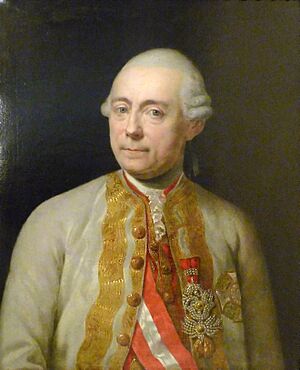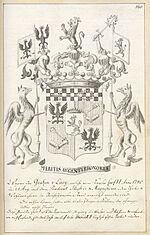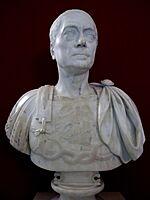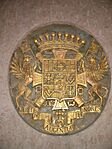Franz Moritz von Lacy facts for kids
Quick facts for kids
Graf
Franz Moritz von Lacy
|
|
|---|---|

Count von Lacy
|
|
| Born | 21 October 1725 Saint Petersburg, Russian Empire |
| Died | 24 November 1801 (aged 76) Vienna, Archduchy of Austria, Holy Roman Empire |
| Buried |
Neuwaldegg, Vienna
|
| Allegiance | |
| Service/ |
Habsburg Empire |
| Years of service | 1743–1790s |
| Battles/wars | War of the Austrian Succession
Austro-Turkish War |
| Relations | Peter Graf von Lacy (father) |
| Signature | |
Franz Moritz Graf von Lacy (born October 21, 1725 – died November 24, 1801) was a very important Austrian military leader. He was born in Saint Petersburg, Russia. His father, Peter von Lacy, was also a famous general. Franz Moritz became a field marshal, which is a very high rank in the army. He served during the time of Empress Maria Theresa and was a close friend and advisor to Joseph II, Holy Roman Emperor. He was also given the special title of a count in the Holy Roman Empire.
Contents
A Young Soldier's Start
Franz Moritz was the son of Count Peter von Lacy. His father was a Russian Field Marshal from an Irish family. Franz Moritz was born in St Petersburg, Russia. He went to school in Germany to prepare for a military career.
He joined the Austrian army in 1743. He fought in places like Italy, Bohemia, Silesia, and the Netherlands during the War of the Austrian Succession. He was wounded twice during this war. By the end of the war, he was a lieutenant-colonel. When he was 25, he became a full colonel and led an infantry regiment.
Fighting in the Seven Years' War
In 1756, the Seven Years' War began, and Franz Moritz was back in action. In the first battle, called Lobositz, he fought so well that he was quickly promoted to major-general. He was wounded for the third time in this battle. He was wounded again, for the fourth time, at the Battle of Prague in 1757.
Later in 1757, Lacy played a big part in the Austrian victory at Breslau. At the Leuthen, where he got his fifth wound, he helped the defeated army retreat safely. After this, he started working closely with Field-Marshal Daun, who was the main general for the empress. These two commanders, later helped by the brilliant general Laudon, fought against Frederick the Great for the rest of the war.
Lacy became a lieutenant field-marshal at age 32. He was made chief of staff for Daun, helping to plan army movements. They were very careful because they had learned to respect Frederick after many defeats. But they were determined to wear out the enemy. So, for several years, Lacy's life was all about the war against Prussia. After the Hochkirch in 1758, Lacy received a very high award, the Grand Cross of the Order of Maria Theresa.
In 1759, both Daun and Lacy faced criticism for not winning more battles. Lacy was promoted to Feldzeugmeister, a high rank, partly because Laudon had just received it for his success at Kunersdorf. Lacy also followed Frederick the Great's army during the failed Siege of Dresden in 1760. The stress of these campaigns was hard on Lacy. Even Daun doubted if Lacy could lead the entire army. Daun refused to give him command when he was wounded at the Battle of Torgau.
Leading the Army and Later Life
After the Treaty of Hubertusburg ended the Seven Years' War, Lacy found new important work. Empress Maria Theresa put her son, Emperor Joseph II, in charge of the Austrian military. Lacy was made a field marshal and given the job of making the army better (in 1766). He created new rules for each part of the army. He also set up new military laws and a good system for supplying the troops. Because of his hard work, the Austrian army became larger, much better equipped, and cost less money than before.
Joseph II became very close with Lacy, his military advisor. Even when Maria Theresa and Joseph II had disagreements, she still trusted Lacy completely. Lacy's work was not just about the army. He supported Joseph's new ideas for the country. Maria Theresa even saw him as a key person in the plan to divide Poland.
However, all this hard work made Lacy sick. In 1773, even though Maria Theresa and the emperor asked him to stay, he left all his official jobs and went to southern France to recover. When he returned, he still couldn't take on his old roles. But he continued to give unofficial advice on political and military matters.
In the short War of the Bavarian Succession, Lacy and Laudon were the main Austrian commanders fighting against the King of Prussia. When Maria Theresa died, Joseph II became the ruler of Austria. Lacy remained his most trusted friend.
A more serious conflict was the Turkish war that started later. By this time, Lacy was old and tired. He didn't have as much success in this war as he had before, just like other Austrian generals. His active military career ended. However, he continued to be interested in state and army affairs during the rule of Joseph's successor, Leopold II.
His last years were spent quietly at his Neuwaldegg Castle near Vienna. He is buried in a special tomb on the castle grounds.
See also





